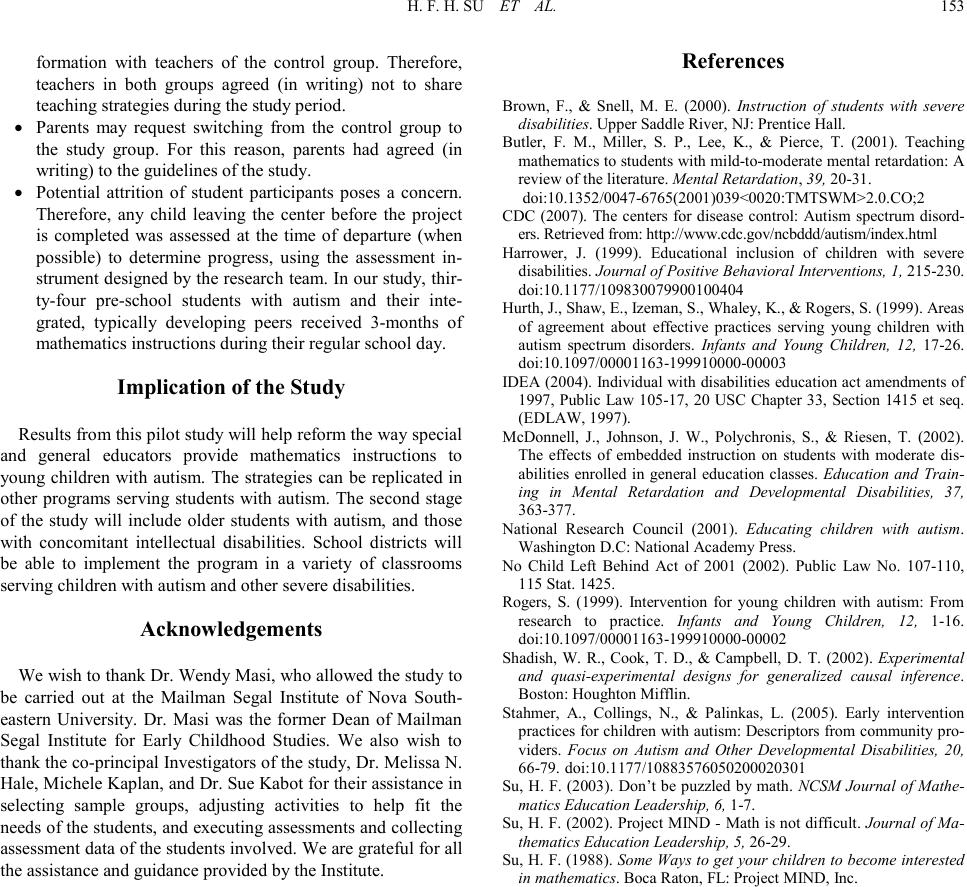
H. F. H. SU ET AL.
formation with teachers of the control group. Therefore,
teachers in both groups agreed (in writing) not to share
teaching strategies during the study period.
• Parents may request switching from the control group to
the study group. For this reason, parents had agreed (in
writing) to the guidelines of the study.
• Potential attrition of student participants poses a concern.
Therefore, any child leaving the center before the project
is completed was assessed at the time of departure (when
possible) to determine progress, using the assessment in-
strument d esigned by the researc h team. In our study, thir-
ty-four pre-school students with autism and their inte-
grated, typically developing peers received 3-months of
mathematics instructions during their regular school day.
Implication of the Study
Results from this pilot study will h elp reform the way special
and general educators provide mathematics instructions to
young children with autism. The strategies can be replicated in
other programs serving students with autism. The second stage
of the study will include older students with autism, and those
with concomitant intellectual disabilities. School districts will
be able to implement the program in a variety of classrooms
serving children with autism and other severe disabilities.
Acknowledgement s
We wish to thank Dr. Wendy Masi, who allowed the study to
be carried out at the Mailman Segal Institute of Nova South-
eastern University. Dr. Masi was the former Dean of Mailman
Segal Institute for Early Childhood Studies. We also wish to
thank the co-principal Investigato rs of the study, Dr. Melissa N.
Hale, Mi chel e Kapl an, and Dr . Sue Kabo t for their as sistan ce in
selecting sample groups, adjusting activities to help fit the
needs o f the stu dent s, and execut ing assess ments an d col lectin g
assessmen t d ata o f the studen ts invol ved. We are grate ful for al l
the assistance and guidance provided by the Institute.
References
Brown, F., & Snell, M. E. (2000). Instruction of students with severe
disabilities. Upper Saddle River, NJ : Prent ice Hall.
Butler, F. M., Miller, S. P., Lee, K., & Pierce, T. (2001). Teaching
math emati cs to stu dents with mild -to-moderat e ment al ret arda tio n: A
review of the literature. Ment al Retardat ion, 39, 20-31.
doi:10.1352/0047-6765(2001)039<0020:TMTSWM>2.0.CO;2
CDC (2007). The centers for disease control: Autism sp ectrum di sord-
ers. Retrieved from: http://www.cdc.gov/ncbddd/autism/index.html
Harrower, J. (1999). Educational inclusion of children with severe
disabilities. Journal of Positive Behavioral Interventions, 1, 215-230.
doi:10.1177/109830079900100404
Hurth, J., Shaw, E., Izeman, S., Whaley, K., & Rogers, S. (1999). Areas
of agreement about effective practices serving young children with
autism spectrum disorders. Infants and Young Children, 12, 17-26.
doi:10.1097/00001163-19991 0000-00003
IDE A (2004). Individual with disab ilities education act amendments of
1997, Public Law 105-17, 20 USC Chapter 33, Section 1415 et seq.
(EDLAW, 1997).
McDonnell, J., Johnson, J. W., Polychronis, S., & Riesen, T. (2002).
The effects of embedded instruction on students with moderate dis-
abilities enrolled in general edu cation classes. Education and Train-
ing in Mental Retardation and Developmental Disabilities, 37,
363-377.
National Research Council (2001). Educating children with autism.
Washington D.C: National Academy Press.
No Child Left Behind Act of 2001 (2002). Public Law No. 107-110,
115 St a t . 1 425.
Rogers, S. (1999). Intervention for young children with autism: From
research to practice. Infants and Young Children, 12, 1-16.
doi:10.1097/00001163-19991 0000-00002
Shadish, W. R., Cook, T. D., & Campbell, D. T. (2002). Experimental
and quasi-experimental designs for generalized causal inference.
Boston: Houghton Mifflin.
Stahmer, A., Collings, N., & Palinkas, L. (2005). Early intervention
practices for c hildren with auti sm: Descriptors from com munity pro-
viders. Focus on Autism and Other Developmental Disabilities, 20,
66-79. doi:10.1177/1088 3576050200020301
Su, H. F. (2003). Don’t be puzzled by math. NCSM Jour nal of Mathe-
matics Education Leadership, 6, 1-7.
Su, H. F. (2002). P roject M IND - Math is not difficult. Jou rnal of Ma-
thematics Education Leader ship, 5, 26-29.
Su, H. F. (1988). Some Ways to get your children to become interested
in mathematics. Boca Raton, FL: Project MIND, Inc.